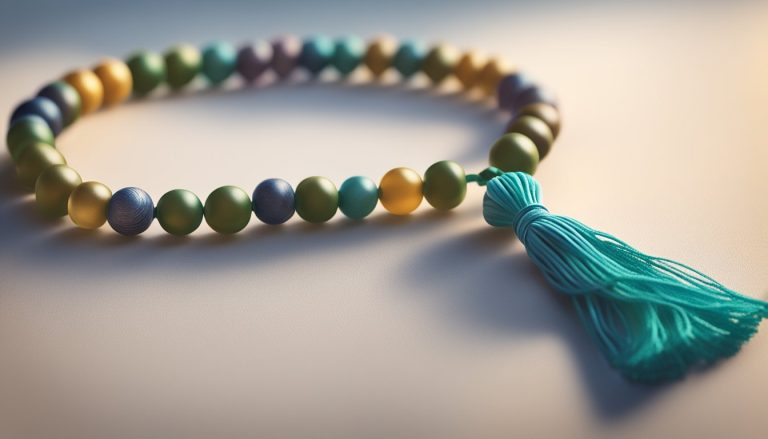Mantra Meditation with Malas: Enhancing Focus and Spirituality
Mantra meditation is a form of mindfulness practice that harnesses the power of vocal or mental repetition to focus and calm the mind.
Within this practice, the use of a mala, a strand of beads typically consisting of 108 beads, aids in keeping track of the mantra recitations.
This tactile approach of feeling each bead pass through the fingers serves as a soothing physical anchor for the meditation process.

Malas have been utilized in a variety of spiritual traditions, and their beads are often made from seeds, wood, or gemstones, each holding specific energetic properties.
As each bead represents a repetition of the mantra, this practice is also known as ‘japa meditation’. This combination of verbal or silent mantra recitation with the rhythmic movement of fingers on beads embeds the meditative process with a profound physical rhythm, deepening the experience and potentially enhancing the meditator’s focus.
Key Takeaways
- Mantra meditation uses repetition of sacred words to focus the mind.
- Malas support mantra meditation by helping track the number of recitations.
- This practice offers a method of achieving tranquility and mindfulness.
Understanding Mantra Meditation
In my exploration of mantra meditation, it’s evident that this practice is much more than just repeating words; it’s about cultivating spiritual energy and focusing the mind.
Origins and Meanings
Mantra meditation stems from ancient traditions, where Sanskrit phrases, known as mantras, are used as tools to help focus and transform consciousness.
Each mantra has its unique vibration, believed by practitioners to resonate with certain energies within and around me. For example, the mantra “Om,” a sound often referred to as the universe’s vibration, is one of the most renowned and embodies the essence of the ultimate reality or consciousness.
Mantras and Their Purpose
My experience with mantras reveals that they serve a dual purpose: focusing my mind during meditation and allowing me to tap into a source of spiritual energy.
By silently reciting a mantra, like “Om,” I aim to clear my mind of distractions and go deeper into a meditative state. Let me demonstrate a typical structure of mantras in their application:
- Mantra: Om Mani Padme Hum
- Translation: The jewel is in the lotus
- Intent: I invoke the embodiment of compassion
Through the repetition of a mantra, I seek both psychological and spiritual benefits, such as increased concentration, emotional balance, and a deeper sense of inner peace.
Exploring Malas
In my journey with mantra meditation, I’ve discovered that malas are not only practical tools but also hold deep spiritual significance. They guide the rhythm of my recitations and enhance my focus during meditation.
Significance of 108 Beads
Each mala traditionally has 108 beads plus one guru bead. I’ve learned that this number is considered sacred in many spiritual traditions, symbolizing the universe’s completeness.
As I circle around my mala, reciting a mantra for each bead, it feels like a full journey of the self coming back to the starting point at the guru bead.
Various Materials Used
Malas are crafted from a variety of materials, each with its own unique properties and significance:
- Wood: Commonly used for its organic feel and grounding properties.
- Seeds: Like rudraksha or lotus seeds, these are often chosen for their connection to spiritual practices.
- Precious Stones: Gemstones such as amethyst or rose quartz are selected for their energies and healing qualities.
- Silk: Sometimes used in the threading of a mala for its durability and smooth texture.
I select my mala based on the material that resonates with my intentions.
Choosing Your Mala
When I choose my mala, I trust my intuition. Here’s what I consider:
- The purpose of my meditation practice.
- The material’s significance that aligns with my needs.
- How the mala feels in my hands.
My mala is more than just a meditation accessory; it’s a personal amulet that carries my intentions and energies.
The Practice of Mantra Meditation
Mantra meditation is a focused practice where I combine mantra recitation with the rhythmic use of a mala to enhance concentration and intention.
It is a deeply personal experience that often involves the repetition of sacred sounds, and the mala serves as a tactile guide through the meditation session.
Preparing for Meditation
Before I begin mantra meditation, I make sure to find a quiet space where I won’t be disturbed. I sit in a comfortable position, with my spine straight to facilitate the flow of energy. Setting a clear intention for my meditation session is crucial. It’s this intention that guides my focus throughout the practice.
- Intention: I clearly define my purpose for meditating, whether it’s seeking calmness, clarity, healing, or spiritual connection.
- Environment: I prepare my surroundings to promote tranquility, sometimes including cushions for comfort and lighting incense or a candle.
Techniques for Using Malas
Japa mala, which usually consists of 108 beads, is a string of beads used to count the recitations of mantras during meditation. Here’s how I use it:
- Holding the Mala: I hold my japa mala in my right hand, draped between my middle and index finger.
- Starting Point: I begin with the ‘guru’ bead—the largest bead in the mala—using it as my starting and ending point.
- Mantra Recitation: For each bead, I recite my chosen mantra once, which may be something like “Om Mani Padme Hum”.
- Movement of Beads: As I recite the mantra, I use my thumb to pull one bead towards me at a time, moving to the next bead with each repetition.
- Focus: My breathing becomes synced with the movement and sound, maintaining a steady rhythm that draws me deeper into a meditative state.
- Full Circuit: Once I complete the circuit around the mala, reaching the guru bead again, I can either stop my session or reverse direction for further contemplation.
Incorporating Malas into Yoga and Mindfulness
When I integrate malas into my yoga and mindfulness practices, I find that they bring a tangible focus to my intention setting and breath work. Malas assist me in maintaining a rhythm during mantra recitation, which enriches my yoga poses and mindfulness routines.
Yoga Poses with Mala Beads
In my personal practice, I’ve discovered that certain yoga poses pair beautifully with mala beads, facilitating deeper concentration and enhancing the flow of energy. Here are two specific poses that I use:
1. Tadasana (Mountain Pose): While standing, I hold my mala beads at heart level, setting an intention with each bead as I breathe deeply.
2. Padmasana (Lotus Pose): Sitting with my spine straight, I drape the mala over my fingers, allowing the beads to pass through with each chant, keeping my focus steady and aligned.
Cultivating Awareness and Mindfulness
To enhance my mindfulness, I use mala beads as a tactile guide that brings my attention back whenever it wanders. This is how I integrate them into my practice:
- Counting Breaths: Holding a bead for each inhalation and exhalation, I find my awareness sharpening as I move through the mala.
- Mantra Recitation: With each bead, I silently repeat a chosen mantra, which helps to anchor my focus and deepen my state of meditation.
Frequently Asked Questions
In this section, I’ll answer some common questions about using mala beads during Mantra meditation to help deepen your practice and connect with the tradition.
How can I properly use mala beads during meditation?
To use mala beads in meditation, I start by holding my mala with one bead next to the guru bead between my thumb and middle finger. I recite my chosen mantra silently or aloud and move to the next bead for each repetition, continuing this cycle until I reach the guru bead again.
What are some effective mala mantras for meditation?
Some effective mantras I may use include “Om Mani Padme Hum” for compassion and “Om Namah Shivaya” for inner peace. The choice of mantra can depend on personal intentions or spiritual guidance.
How do I activate my mala beads for use in meditation?
Activating my mala involves imbuing them with intention and energy. I may perform a simple ceremony where I hold my mala in my hands, recite my chosen mantra 108 times, and visualize my energy charging the beads.
What are the best mala beads for meditation?
The best mala beads for meditation are those made from materials that resonate with me personally. Many practitioners prefer beads made from natural stones like rudraksha or crystals. These materials are known for their energetic properties.
Can wearing mala beads be considered disrespectful in certain cultures?
Wearing mala beads can be seen as disrespectful if I do not wear them with reverence and understanding of their spiritual significance. I should respect these beads as sacred tools for meditation, and not as mere fashion accessories.
Are there specific mala beads recommended for managing anxiety?
Yes, mala beads made from amethyst or blue lace agate are often recommended for managing anxiety.
Their calming properties may help soothe the mind and aid in focus during meditation.







